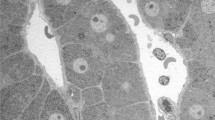Abstract
The cells that I will describe are dying because blood flow has been interrupted: the left lateral and median liver lobes have been made ischaemic by clamping their blood vessels. According to the duration of the interruption of blood supply we can distinguish between: (1) Short- duration ischaemia, lasting 15–30 min and producing slight and easily reversible cellular damage. (2) Long-duration reversible ischaemia, lasting about 60 min and leading to severe but essentially reversible cell damage; no widespread necrosis occurs. (3) Long-duration irreversible ischaemia, lasting 120 min. The term irreversible does not refer to the interruption of the blood flow, which is re-established by removing the clamp after this time, but to the consequence to the tissue, where signs of widespread necrosis become evident later1.
Access this chapter
Tax calculation will be finalised at checkout
Purchases are for personal use only
Preview
Unable to display preview. Download preview PDF.
Similar content being viewed by others
References
Bernelli-Zazzera, A., Gaja, G. (1964). Some aspects of glycogen metabolism following reversible or irreversible liver ischemia. Exp. Molec. Pathol., 3, 351–368
Ragnotti, G., Cajone, F., Bernelli-Zazzera, A. (1970). Structural and functional changes in polysomes from ischemic livers. Exp. Molec. Pathol., 13, 295–306
Cajone, F., Schiaffonati, L., Bernelli-Zazzera, A. (1973). The binding of ribosomes to rat liver endoplasmic-reticulum membranes in vitro: effects of ischaemia. Biochem. Soc. Trans., 1, 945–947
Cajone, F., Schiaffonati, L., Piccoletti, R., Bernelli-Zazzera, A. (1974). Ribosome-membrane relationships in ischemic livers. Exp. Molec. Pathol., 21, 40–50
Cajone, F., Schiaffonati, L. (1974). Effects of amino acids on protein synthesis by cellular and subcellular preparations from ischaemic livers. Brit. J. Exp. Pathol, (in press)
Bernelli-Zazzera, A., Cajone, F., Simonetta, M., Schiaffonati, L., Piccoletti, R. (1972). Further studies on ribosomal damage in liver ischemia. Exp. Molec. Pathol., 17, 121–131
Noll, H. (1969). Polysomes: analysis of structure and function. In: Techniques in Protein Biosynthesis, 2, 101–179 (P- N. Campbell and J. R. Sargent, editors) (London: Academic Press)
Falvey, A. K., Staehelin, T. (1970). Structure and function of mammalian ribosomes. II. Exchange of ribosomal subunits at various stages of in vitro polypeptide synthesis. J. Molec. Biol., 53, 21–34
Henshaw, E. C., Hirsch, C. A., Morton, B. E., Hiatt, H. H. (1971). Control of protein synthesis in mammalian tissues through changes in ribosome activity. J. Biol. Chem., 246, 436–446
Ashworth, C. T., Werner, D. J., Glass, M. D., Arnold, N. J. (1965). Spectrum of fine structural changes in hepatocellular injury due to thioacetamide. Amer. J. Pathol., 47, 917–951
Vogt, M., Farber, E. (1968). On the molecular pathology of ischemic renal cell death. Reversible and irreversible cellular and mitochondria metabolic alterations. Amer. J. Pathol., 53, 1–24
Gaja, G., Bernelli-Zazzera, A., Sorgato, G. (1965). Glycolysis in dying liver cells. Exp. Molec. Pathol., 4, 275–281
Ragnotti, G., Gaja, G., Bernelli-Zazzera, A. (1968). Decline and restoration of glycolysis in homogenates. Exp. Molec. Pathol., 9, 148–159
Gaja, G., Ferrerò, M. E., Piccoletti, R., Bernelli-Zazzera, A. (1973)Phosphorylation and redox states in ischemic liver. Exp. Molec. Pathol 19, 248–265
Bassi, M., Bernelli-Zazzera, A. (1964). Ultrastructural cytoplasmic changes of liver cells after reversible and irreversible ischemia. Exp. Molec. Pathol., 3, 332–350
Majno, G., La Gattuta, M., Thompson, T. E. (1960). Cellular death and necrosis: chemical, physical and morphologic changes in rat liver. Virchows Arch. Pathol. Anat., 333, 421–465.
Editor information
Editors and Affiliations
Rights and permissions
Copyright information
© 1975 D. Keppler
About this chapter
Cite this chapter
Bernelli-Zazzera, A. (1975). Ribosomes in dying liver cells. In: Keppler, D. (eds) Pathogenesis and Mechanisms of Liver Cell Necrosis. Springer, Dordrecht. https://doi.org/10.1007/978-94-011-6618-8_10
Download citation
DOI: https://doi.org/10.1007/978-94-011-6618-8_10
Publisher Name: Springer, Dordrecht
Print ISBN: 978-94-011-6620-1
Online ISBN: 978-94-011-6618-8
eBook Packages: Springer Book Archive




